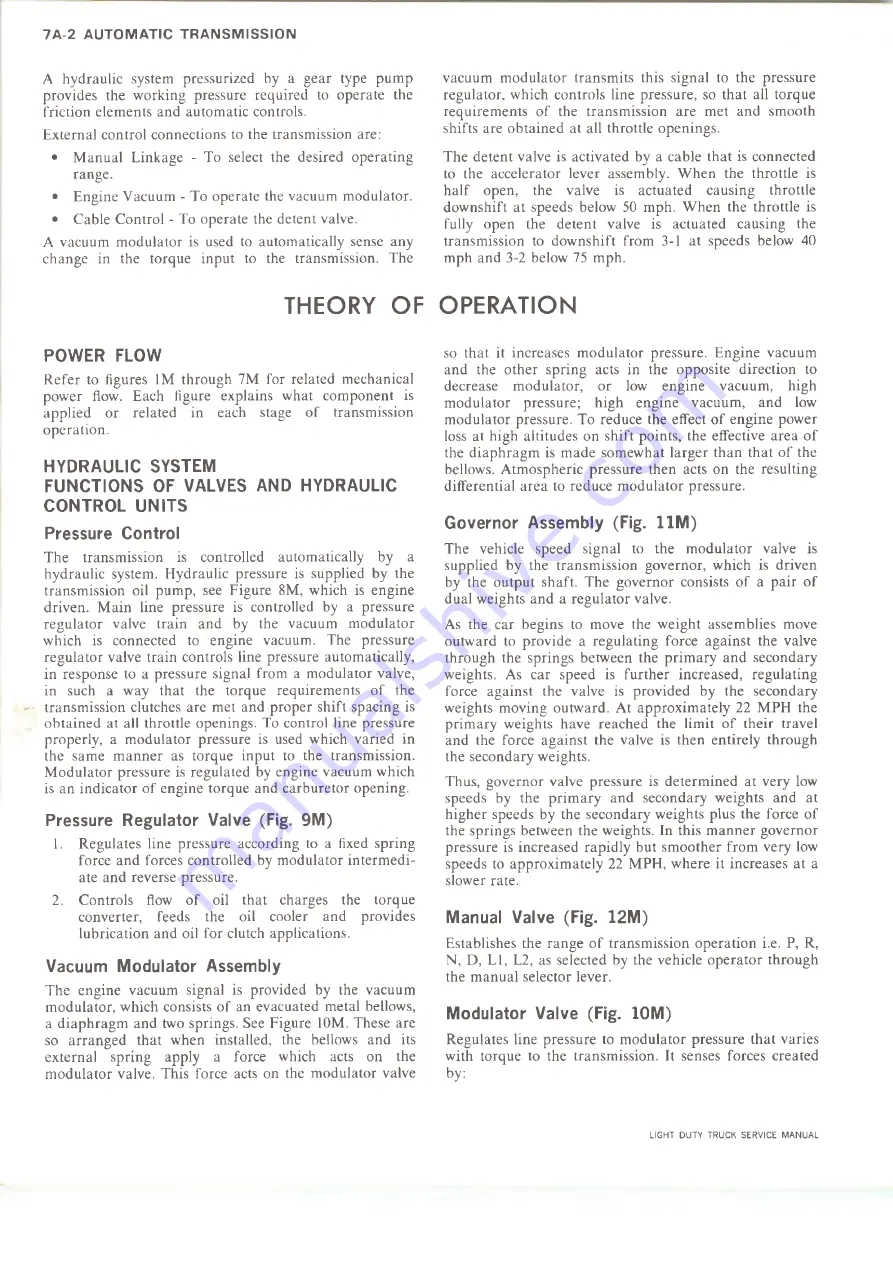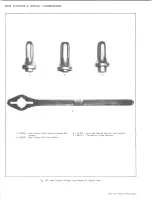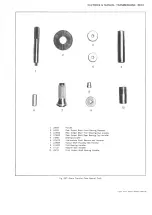
7 A-2 A U T O M A T IC T R A N S M IS S IO N
A hydraulic system pressurized by a gear type pump
provides the working pressure required to operate the
friction elements and automatic controls.
External control connections to the transmission are:
• Manual Linkage - To select the desired operating
range.
• Engine Vacuum - To operate the vacuum modulator.
• Cable Control - To operate the detent valve.
A vacuum modulator is used to automatically sense any
change in the torque input to the transmission. The
THEORY OF
POWER FLOW
Refer to figures 1M through 7M for related mechanical
power flow. Each figure explains what component is
applied or related in each stage of transmission
operation.
HYDRAULIC SYSTEM
FUNCTIONS OF VALVES AND HYDRAULIC
CONTROL UNITS
Pressure Control
The transmission is controlled automatically by a
hydraulic system. Hydraulic pressure is supplied by the
transmission oil pump, see Figure 8M, which is engine
driven. Main line pressure is controlled by a pressure
regulator valve train and by the vacuum modulator
which is connected to engine vacuum. The pressure
regulator valve train controls line pressure automatically,
in response to a pressure signal from a modulator valve,
in such a way that the torque requirements of the
transmission clutches are met and proper shift spacing is
obtained at all throttle openings. To control line pressure
properly, a modulator pressure is used which varied in
the same manner as torque input to the transmission.
Modulator pressure is regulated by engine vacuum which
is an indicator of engine torque and carburetor opening.
Pressure Regulator Valve (Fig. 9M)
1. Regulates line pressure according to a fixed spring
force and forces controlled by modulator intermedi
ate and reverse pressure.
2. Controls flow of oil that charges the torque
converter, feeds the oil cooler and provides
lubrication and oil for clutch applications.
Vacuum Modulator Assembly
The engine vacuum signal is provided by the vacuum
modulator, which consists of an evacuated metal bellows,
a diaphragm and two springs. See Figure 10M. These are
so arranged that when installed, the bellows and its
external spring apply a force which acts on the
modulator valve. This force acts on the modulator valve
vacuum modulator transmits this signal to the pressure
regulator, which controls line pressure, so that all torque
requirements of the transmission are met and smooth
shifts are obtained at all throttle openings.
The detent valve is activated by a cable that is connected
to the accelerator lever assembly. When the throttle is
half open, the valve is actuated causing throttle
downshift at speeds below 50 mph. When the throttle is
fully open the detent valve is actuated causing the
transmission to downshift from 3-1 at speeds below 40
mph and 3-2 below 75 mph.
OPERATION
so that it increases modulator pressure. Engine vacuum
and the other spring acts in the opposite direction to
decrease modulator, or low engine vacuum, high
modulator pressure; high engine vacuum, and low
modulator pressure. To reduce the effect of engine power
loss at high altitudes on shift points, the effective area of
the diaphragm is made somewhat larger than that of the
bellows. Atmospheric pressure then acts on the resulting
differential area to reduce modulator pressure.
Governor Assembly (Fig. 11M)
The vehicle speed signal to the modulator valve is
supplied by the transmission governor, which is driven
by the output shaft. The governor consists of a pair of
dual weights and a regulator valve.
As the car begins to move the weight assemblies move
outward to provide a regulating force against the valve
through the springs between the primary and secondary
weights. As car speed is further increased, regulating
force against the valve is provided by the secondary
weights moving outward. At approximately 22 MPH the
primary weights have reached the limit of their travel
and the force against the valve is then entirely through
the secondary weights.
Thus, governor valve pressure is determined at very low
speeds by the primary and secondary weights and at
higher speeds by the secondary weights plus the force of
the springs between the weights. In this manner governor
pressure is increased rapidly but smoother from very low
speeds to approximately 22 MPH, where it increases at a
slower rate.
Manual Valve (Fig. 12M)
Establishes the range of transmission operation i.e. P, R,
N, D, LI, L2, as selected by the vehicle operator through
the manual selector lever.
Modulator Valve (Fig. 10M)
Regulates line pressure to modulator pressure that varies
with torque to the transmission. It senses forces created
by:
LIGHT DUTY TRUCK SERVICE MANUAL
Summary of Contents for Light Duty Truck 1973
Page 1: ......
Page 4: ......
Page 6: ......
Page 53: ...HEATER AND AIR CONDITIONING 1A 27 LIGHT DUTY TRUCK SERVICE MANUAL...
Page 115: ...LIGHT DUTY TRUCK SERVICE M A N U A L HEATER AND AIR CONDITIONING 1A 89...
Page 123: ...BODY 1B 3 Fig 6 Typical 06 Van LIGHT DUTY TRUCK SERVICE MANUAL...
Page 149: ...BODY 1B 29 Fig 84 Body Mounting 06 Fig 85 Body Mounting 14 LIGHT DUTY TRUCK SERVICE MANUAL...
Page 171: ...LIGHT DUTY TRUCK SERVICE M A N U A L Fig 2 Frame Horizontal Checking Typical FRAME 2 3...
Page 173: ...LIGHT DUTY TRUCK SERVICE M A N U A L Fig 4 10 30 Series Truck Frame FRAME 2 5...
Page 174: ...2 6 FRAME LIGHT DUTY TRUCK SERVICE MANUAL Fig 5 Underbody Reference Points G Van...
Page 185: ...FRONT SUSPENSION 3 11 Fig 16 Toe out on Turns LIGHT DUTY TRUCK SERVICE MANUAL...
Page 224: ......
Page 266: ......
Page 351: ...ENGINE 6 15 Fig ID Sectional View of Eight Cylinder Engine LIGHT DUTY TRUCK SERVICE MANUAL...
Page 375: ...EN G IN E 6 39 LIGHT DUTY TRUCK SERVICE MANUAL...
Page 376: ...6 4 0 ENGINE LIGHT DUTY TRUCK SERVICE MANUAL...
Page 377: ...ENG IN E 6 41 LIGHT DUTY TRUCK SERVICE MANUAL...
Page 378: ...LIGHT DUTY TRUCK SERVICE MANUAL Fig 37L K Series Engine Front Mount 6 42 ENG INE...
Page 400: ...6 6 4 ENG INE LIGHT DUTY TRUCK SERVICE MANUAL...
Page 401: ...ENG IN E 6 65 LIGHT DUTY TRUCK SERVICE MANUAL...
Page 402: ...6 6 6 ENGINE LIGHT DUTY TRUCK SERVICE MANUAL...
Page 403: ...E NG IN E 6 67 Fig 36V C Series Engine Mounts LIGHT DUTY TRUCK SERVICE MANUAL...
Page 410: ......
Page 423: ...EN G IN E C OOLING 6K 13 Fig 16 Overheating Chart LIGHT DUTY TRUCK SERVICE MANUAL...
Page 424: ...6 K 1 4 ENG INE COOLING Fig 17 Coolant Loss Chart LIGHT DUTY TRUCK SERVICE MANUAL...
Page 456: ...6M 32 ENGINE FUEL Fig K15 Accelerator Controls G Van L 6 LIGHT DUTY TRUCK SERVICE MANUAL...
Page 492: ......
Page 512: ...Fig 18e Vacuum Advance Diagram V8 Engine...
Page 516: ...6 T 2 4 E M IS S IO N CONTROL SYSTEMS LIGHT DUTY TRUCK SERVICE MANUAL...
Page 528: ......
Page 590: ......
Page 593: ...CLUTCHES MANUAL TRANSMISSIONS 7M 3 LIGHT DUTY TRUCK SERVICE MANUAL...
Page 598: ...7M 8 CLUTCHES MANUAL TRANSMISSIONS LIGHT DUTY TRUCK SERVICE MANUAL...
Page 642: ......
Page 654: ......
Page 743: ...FUEL TANKS AND EXHAUST 8 13 LIGHT DUTY TRUCK SERVICE MANUAL...
Page 744: ...8 14 FUEL TANKS AND EXHAUST LIGHT DUTY TRUCK SERVICE MANUAL...
Page 760: ...8 30 FUEL TANKS AND EXHAUST Fig 40 Exhaust Pipe P Models LIGHT DUTY TRUCK SERVICE MANUAL...
Page 761: ...FUEL TANKS AND EXHAUST 8 31 LIGHT DUTY TRUCK SERVICE MANUAL...
Page 763: ...FUEL TANKS AND EXHAUST 8 33 LIGHT DUTY TRUCK SERVICE MANUAL...
Page 766: ......
Page 832: ...LIGHT DUTY TRUCK SERVICE MANUAL Fig 106 Power Steering Pump Mounting Typical 9 66 STEERING...
Page 833: ...PUMP ASSEMBLY STEERING GEAR TYPICAL SMALL V8 TYPICAL LARGE V8 STEERING 9 67...
Page 861: ...STEERING 9 95 Fig 134 Power Steering Pump Leakage LIGHT DUTY TRUCK SERVICE MANUAL...
Page 864: ......
Page 876: ......
Page 886: ...11 10 CHASSIS SHEET METAL LIGHT DUTY TRUCK SERVICE MANUAL...
Page 891: ...ELECTRICAL BODY AND CHASSIS 12 5 LIGHT DUTY TRUCK SERVICE MANUAL...
Page 934: ......
Page 942: ......
Page 970: ......
Page 972: ......
Page 974: ......
Page 976: ...V...
Page 978: ......
Page 979: ......





































